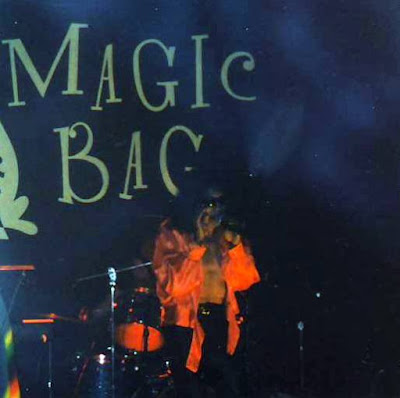As soon as the sound of the cascading drums comes crashing down on the opening number “The Log Book,” their 5th album veers off into a multitude of unexpected directions. While it was somewhat common for the '60s bands to put their exploratory song suites, jams or long number on side two (like “Revelation” by Love on their Da Capo album or the Who’s "A Quick One, While He's Away" to conclude A Quick One), Freezing Hands flip the convention and start strange right from the start on Side A-Wax.
Upon initial listens, Side A-Wax does not start as immediate as its four predecessors, but reveals its depth and breadth-in its own time. They open the doors to their own Butterscotch Cathedral as there seems to be a sense of beatific religious imagery and philosophical notions coursing through these songs which chase shadows of belief and disbelief. Both the literary (inspired by Joyce? Vonnegut?) and the quotidian clash and converge within the lyrics to act as an invocation to ask further questions without scripted answers. Spillers’ somewhat cryptic language expresses and reflects lived experience from rakish rooms filled with the shards of shattered records and bad canned goods to those as an everyday educator attuned to the plight of the slighted and marginalized.
All paths lead to the title track where years of listening to Johnny Mathis, Sergio Mendes, Scott Walker, Bacharach, Love and the Zombies culminates in this free flowing bossa-infused number which is one of the best and most brilliant songs in their entire catalog. Here, they turn the necessary corner from where things don’t make sense, to where they do. The sound of the words work in unison with the music and provide the poetry-in-motion permeating the album. “The Meek and the Mild” immediately brings to mind Minus 5 meets early ‘70s solo Paul Simon. Spiraling Dylan-esque lyrics wind like the roads up Tucson’s Mt. Lemmon to reach the truism of “One things for sure - nothing’s for sure” buttressed by assuring and soaring sundown harmonies.
Side B-Wane brings the Bowie beat to Rodney's English disco with Fowley lurking in the shadows on the stomping “Steppin’ to Holy Cow.” Its glittering melody was running through my head when I woke up the other night, which is not a bad thing at all. This glam slam could also have a strong appeal to listeners of the Lemon Twigs, Tchotchke, Uni Boys and Billy Tibbals. The skewering “Shooting from the Hip” is the album’s most jagged and riveting number and evokes Scared of Chaka when they were on Sub City. Hardly any traces of punk remain in the Hands' sound on this release, but they are still totally punk in spirit. Be sure to catch Kim Shattuck-ish yowl growl and Kevin Conklin’s menacing bass sound scraped off the cinderblock walls of Midtown Island Studio and layered thick upon the tape.
“Fading Balloons” could have been the flip-side to “Nuthin’ in the Tank” from their preceding album with melodies and harmonies that recall Lost Balloons and Harsh Mistress. Scott Landrum provides some of the most delightful and apt keyboard playing since heard on those two Zumpano albums from 30 years ago. Presenting a view from above, “I’m on a 10,” shares sentiments with the Sesame Street (Ernie!) song “I Don’t Want to Go to the Moon.” Meanwhile, the music recalls Badfinger with its guitar riff nick of “No Matter What” in particular. With its Sha Na Na/Bowser-ish utterance of “Yeaah,” “Long in the Lung” reminds me of the 2010’s, when many bands were unabashed about unleashing their ‘50s rock & roll influences. Here, they throw their words and music into their own Freezing Hands blender to whip up quite a concoction to the beat of Matt Rendon's propulsive drumming. The album ends on the edges of classic rock with a sense of acute strangeness that permeates the first Alice Cooper album (Pretties for You) along the forward push of “Vehicle” by Ides of March.

Despite All the Complications
These lyrics are delivered with considerable finesse and make this sort of a singer-songwriter album in the best sense like One Year by Colin Blunstone or those Scott Walker albums, but without the lavish orchestration. Spillers taps into his vast reservoir of words and images and offers character studies, detached observations and coded socio-political commentary along with his ever-present large sense of the absurd and heartfelt gratitude for the basic enjoyable things of life like donuts, baseball and libraries. Overall, it’s their most stylistically diverse album of all, while all the while maintaining their characteristic catchiness. They have additionally achieved a sense of continuity and momentum that comes with consistent practice and fortitude. No matter how oppositional forces continue to conspire and distractions mount, they still believe, know and express that music & art does make a resounding difference.






















